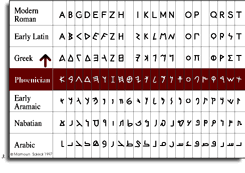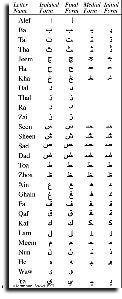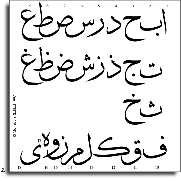Part 1 of 5 articles The Art of Arabic Calligraphy |
||
The Language and The Script© Mamoun Sakkal 1993, updated 12/27/2016 |
||
Arabic belongs to the group of Semitic alphabetical scripts in which mainly the consonants are represented in writing, while the markings of vowels (using diacritics) is optional. The earliest-known alphabet to mankind was the North Semitic, which developed around 1700 B.C. in Palestine and Syria. It consisted of 22 consonant letters. The Arabic, Hebrew, and Phoenician alphabets were based on this model (Fig. 3). Then, around 1000 B.C., the Phoenician alphabet was itself used as a model by the Greeks, who added letters for vowels. Greek in turn became the model for Etruscan (c. 800 B.C.), whence came the letters of the ancient Roman alphabet, and ultimately all Western alphabets. The North Arabic script, which eventually prevailed and became the Arabic script of the Quran, relates most substantially and directly to the Nabatian script, which was derived from the Aramaic script. Old Aramaic, the language of Jesus and the Apostles, dates from the 2nd millennium B.C., and some dialects of which are still spoken by tiny groups in the Middle East. Arabic script still shares with Aramaic the names of the alphabet letters (Alef, Jeem, Dal, Zai, Sheen, etc.); similar graphic representation for phonetically similar letters (Sad and Dad, Ta and Tha, etc.); connections of letters in the same word and several forms of each letter depending on its location in the word, except for letters that cannot be connected to the letters which come after them (Alef, Dal/Dthal, Raa/Zai, Waw, Fig. 1). The Arabic alphabet contains 18 letter shapes, by adding one, two, or three dots to letters with similar phonetic characteristics a total of 28 letters is obtained (Fig. 2). These contain three long vowels, while diacritics can be added to indicate short vowels. |
||
| Fig. 1. The Arabic Alphabet has 28 letters. The shape of these letters changes depending on their position in the word, whether isolated; in the beginning of the word (initial); in the middle (medial); or at the end (final). | ||
 |
|
|
| Fig. 3. The Arabic and Phoenician alphabets, along with several other alphabets such as Hebrew and Aramaic, are based on an early model called the North Semitic. The Phoenician alphabet was adapted by the Greeks, then the Etruscans and Romans, and eventually became the Western alphabet as we know it today. | Fig. 2. Several letters in the Arabic alphabet share the same shape, and are differentiated only by the number and placement of dots on the letters. Of the basic 18 shapes, 2 are used for three letters, 6 are used for two letters, and the remaining 10 are used for one letter each. | |
With the spread of Islam, the Arabic alphabet was adapted by several non-Arab nations for writing their own languages. In Iran Arabic letters were used to write Farsi, with the addition of four letters to represent the phonetics that did not exist in Arabic: p, ch, zh, and g. The Ottoman Turks used the Arabic alphabet until 1929 and added still another letter. This alphabet was also used to write other Turkish languages and dialects, such as Kazakh, Uzbek, etc. Several other languages used the Arabic alphabet at one time or another, including Urdu, Malay, Swahili, Hausa, Algerian Tribal, and others. From its simple and primitive early examples of the 5th and 6th century A.D., the Arabic alphabet developed rapidly after the rise of Islam in the 7th century into a beautiful form of art. The main two families of calligraphic styles were the dry styles, called generally the Kufic, and the soft cursive styles, which include Naskhi, Thuluth, Nastaliq and many others. (Note: For an updated and expanded alphabet chart with notes to help in learning how to write Arabic words, please see here) Article and figures © copyright 1993 by Mamoun Sakkal, updated 12/27/2016 |
Click on image for more details
|
|


